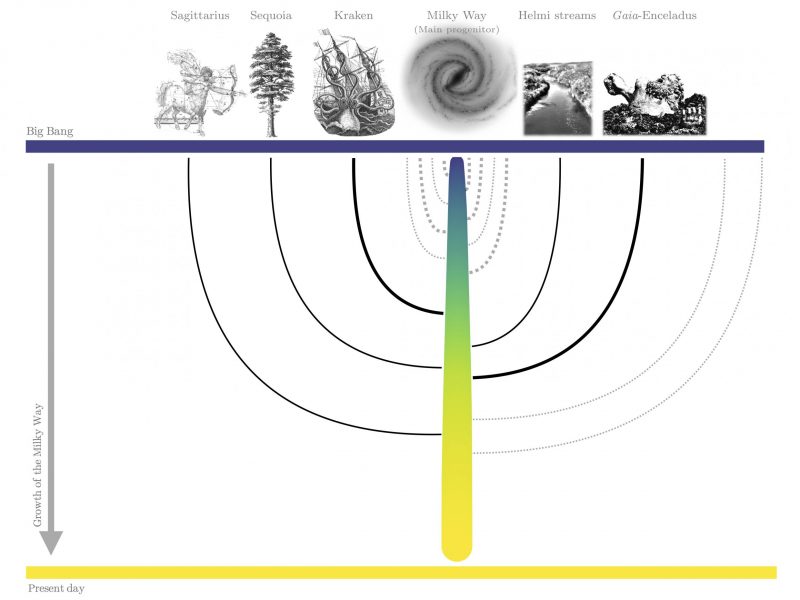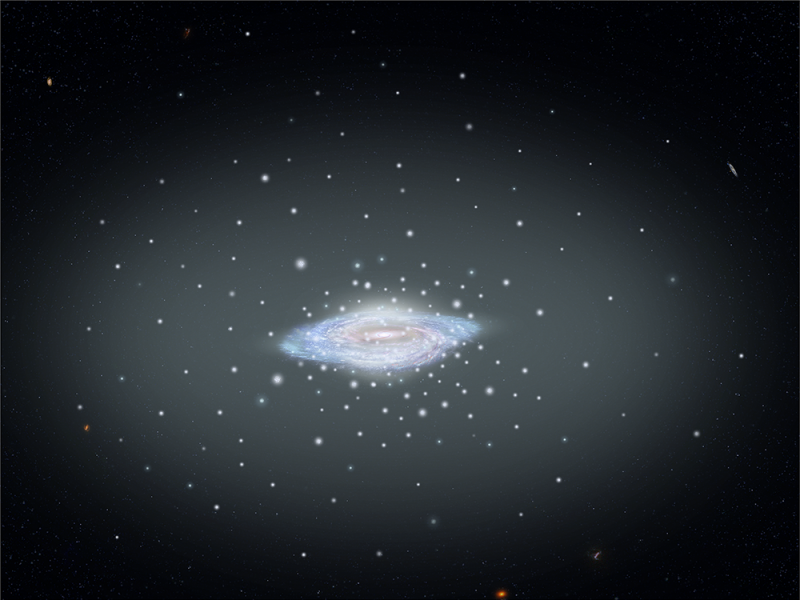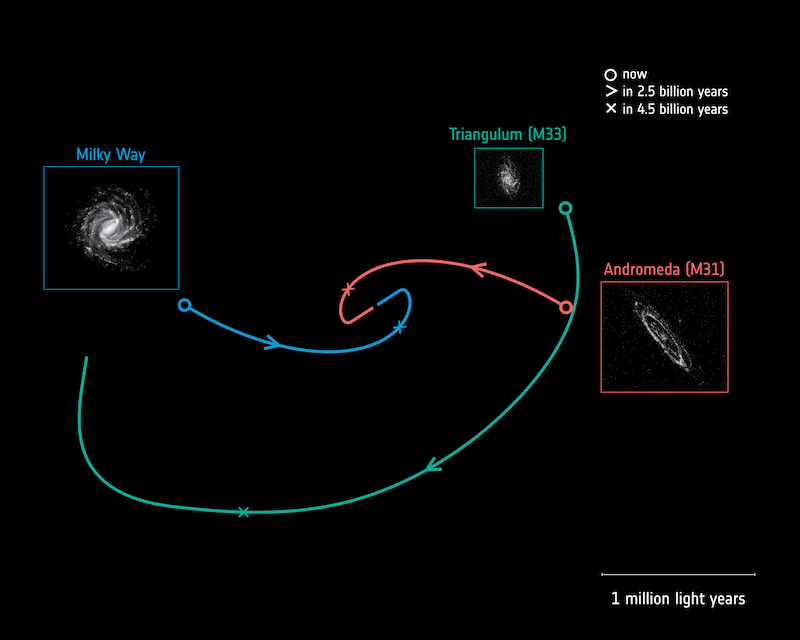
Galaxies, like people and civilizations, have histories and have evolved and changed over billions of years. This is true also, of course, for our home galaxy, the Milky Way. Astronomers at Heidelberg University in Germany – led by Diederik Kruijssen – announced in late November 2020 that they’ve been able to piece together more of the history of our galaxy, to the point of constructing a Milky Way family tree. This family tree traces back the formation process of our galaxy. It shows how our huge Milky Way – our vast island of 100 billion stars in space – started out at least 4 times smaller and then grew, as smaller galaxies merged with it.
A primary merger – with a smaller galaxy now called Kraken by astronomers – is thought to have taken place early in our galaxy’s history, around 11 billion years ago.
The researchers published their peer-reviewed findings in the Monthly Notices of the Royal Astronomical Society.
The findings illustrate the fact that – formerly unbeknownst to us, living here on Earth in our blink of cosmic time – our galaxy’s long history has been complex and chaotic. According to the researchers, the Milky Way cannibalized about five smaller galaxies throughout its lifetime. The astronomers call these galaxies Sagittarius, Sequoia, Kraken, the Helmi stream (which started as a dwarf galaxy), and Gaia-Enceladus. Those five each contained more than 100 million stars. Ten more galaxies – also cannibalized by the Milky Way – contained at least 10 million stars.
The largest of these collisions occurred between 6 and 11 billion years ago. As of now, scientists have found the debris from at least five of those collisions.

The “family tree” of the Milky Way. There are 5 known progenitor galaxies – Sagittarius, Sequoia, Kraken, the Helmi stream (which started as a dwarf galaxy), and Gaia-Enceladus – thought to have merged with the primary part of our Milky Way, 6 to 11 billion years ago. The gray dotted lines depict other mergers that couldn’t be connected to a specific progenitor. Image via D. Kruijssen/ Heidelberg University.
The results come from a new study of globular star clusters, which are symmetrical clusters of up to a million stars. These stars are almost as old as our galaxy – and the universe – itself. Globular star clusters orbit in the halo of our Milky Way galaxy.
And the new results are made possible by advances in artificial intelligence (AI). For example – in this study – AI was used to show that a merger, or collision, with a smaller progenitor galaxy – or protogalaxy, in this case the one called Kraken – permanently changed the appearance of our galaxy.
As Kruijssen explained in a statement:
The collision with Kraken must have been the most significant merger the Milky Way ever experienced. As a result, the collision with Kraken must have truly transformed what the Milky Way looked like at the time.
There are over 150 known globular clusters that orbit the center of our galaxy, and the evidence shows that there have been many such mergers over the lifetime of the Milky Way. Kruijssen said:
Many of them came from smaller galaxies that later merged to form the Milky Way that we live in today.
To recreate this cosmic family tree, the researchers developed a set of new computer simulations called The E-MOSAICS project.
The simulations are very advanced, these astronomers explained, in that they can emulate the formation, evolution, and destruction of globular clusters. They are the first simulations to self-consistently model entire star cluster populations – and their host galaxy – in this way, through cosmic time. The astronomers called them hydrodynamical simulations of galaxy formation; in other words, they were looking at the “fluid” aspect of so many stars moving together in space.
Kruijssen, along with Joel Pfeffer of Liverpool John Moores University in the UK, used the simulations to figure out the ages, chemical compositions, and orbital motions of the globular clusters and how they related to the progenitor galaxies, more than 10 billion years ago.

Diederik Kruijssen at Heidelberg University, who led the new study. Image via Heidelberg University.
The researchers then compared this data to groups of progenitor galaxies that still orbit our Milky Way. By doing so, they were able to precisely determine not only the masses of the galaxies but when they merged together with the Milky Way. Kruijssen elaborated:
The main challenge was that the merger process is extremely messy, because the orbits of the globular clusters are completely reshuffled. To overcome this complexity, we developed an artificial neural network and trained it on the E-MOSAICS simulations. We were astonished at how precisely the artificial intelligence allowed us to reconstruct the merger histories of the simulated galaxies, using only their globular clusters.
Prior to the evidence for the collision with Kraken 11 billion years ago, the previously-known largest collision was with the Gaia-Enceladus galaxy, 9 billion years ago.

Graphic illustration of globular star clusters orbiting our Milky Way galaxy. Over 150 are known of so far. Image via NASA/ Space Telescope Science Institute (STScI)/ Hubblesite.
If these events happened before, could they happen again?
Whether any of the smaller galaxies orbiting the Milky Way will collide with our galaxy isn’t known for sure, scientists have long forecasted that the Andromeda galaxy – the nearest large spiral galaxy – will eventually collide with the Milky Way. The European Space Agency (ESA) provided an update about that back on February 7, 2019. The new estimate, based on the second data release from the Gaia satellite, is that the collision will occur about 4.5 billion years from now, 600 million years later than first thought. It will also probably be more of a glancing blow than a direct collision. Even that, though, might cause significant disruption of some star systems.
The family tree of our galaxy has revealed how the Milky Way has grown over billions of years, from the merging of smaller galaxies. It illustrates how tumultuous the Milky Way’s history has been.
And while things may be quiet right now, it seems there are more cosmic collisions to come …

Scientists expect that, in about 4.5 billion years from now, the Andromeda galaxy with collide with the Milky Way, although it will be more of a “glancing blow.” Image via ESA/Gaia/DPAC.
Bottom line: Scientists have created a new family tree of our Milky Way galaxy, showing how it has grown over billions of years from chaotic mergers with smaller galaxies.
from EarthSky https://ift.tt/3oF5iRc

Galaxies, like people and civilizations, have histories and have evolved and changed over billions of years. This is true also, of course, for our home galaxy, the Milky Way. Astronomers at Heidelberg University in Germany – led by Diederik Kruijssen – announced in late November 2020 that they’ve been able to piece together more of the history of our galaxy, to the point of constructing a Milky Way family tree. This family tree traces back the formation process of our galaxy. It shows how our huge Milky Way – our vast island of 100 billion stars in space – started out at least 4 times smaller and then grew, as smaller galaxies merged with it.
A primary merger – with a smaller galaxy now called Kraken by astronomers – is thought to have taken place early in our galaxy’s history, around 11 billion years ago.
The researchers published their peer-reviewed findings in the Monthly Notices of the Royal Astronomical Society.
The findings illustrate the fact that – formerly unbeknownst to us, living here on Earth in our blink of cosmic time – our galaxy’s long history has been complex and chaotic. According to the researchers, the Milky Way cannibalized about five smaller galaxies throughout its lifetime. The astronomers call these galaxies Sagittarius, Sequoia, Kraken, the Helmi stream (which started as a dwarf galaxy), and Gaia-Enceladus. Those five each contained more than 100 million stars. Ten more galaxies – also cannibalized by the Milky Way – contained at least 10 million stars.
The largest of these collisions occurred between 6 and 11 billion years ago. As of now, scientists have found the debris from at least five of those collisions.

The “family tree” of the Milky Way. There are 5 known progenitor galaxies – Sagittarius, Sequoia, Kraken, the Helmi stream (which started as a dwarf galaxy), and Gaia-Enceladus – thought to have merged with the primary part of our Milky Way, 6 to 11 billion years ago. The gray dotted lines depict other mergers that couldn’t be connected to a specific progenitor. Image via D. Kruijssen/ Heidelberg University.
The results come from a new study of globular star clusters, which are symmetrical clusters of up to a million stars. These stars are almost as old as our galaxy – and the universe – itself. Globular star clusters orbit in the halo of our Milky Way galaxy.
And the new results are made possible by advances in artificial intelligence (AI). For example – in this study – AI was used to show that a merger, or collision, with a smaller progenitor galaxy – or protogalaxy, in this case the one called Kraken – permanently changed the appearance of our galaxy.
As Kruijssen explained in a statement:
The collision with Kraken must have been the most significant merger the Milky Way ever experienced. As a result, the collision with Kraken must have truly transformed what the Milky Way looked like at the time.
There are over 150 known globular clusters that orbit the center of our galaxy, and the evidence shows that there have been many such mergers over the lifetime of the Milky Way. Kruijssen said:
Many of them came from smaller galaxies that later merged to form the Milky Way that we live in today.
To recreate this cosmic family tree, the researchers developed a set of new computer simulations called The E-MOSAICS project.
The simulations are very advanced, these astronomers explained, in that they can emulate the formation, evolution, and destruction of globular clusters. They are the first simulations to self-consistently model entire star cluster populations – and their host galaxy – in this way, through cosmic time. The astronomers called them hydrodynamical simulations of galaxy formation; in other words, they were looking at the “fluid” aspect of so many stars moving together in space.
Kruijssen, along with Joel Pfeffer of Liverpool John Moores University in the UK, used the simulations to figure out the ages, chemical compositions, and orbital motions of the globular clusters and how they related to the progenitor galaxies, more than 10 billion years ago.

Diederik Kruijssen at Heidelberg University, who led the new study. Image via Heidelberg University.
The researchers then compared this data to groups of progenitor galaxies that still orbit our Milky Way. By doing so, they were able to precisely determine not only the masses of the galaxies but when they merged together with the Milky Way. Kruijssen elaborated:
The main challenge was that the merger process is extremely messy, because the orbits of the globular clusters are completely reshuffled. To overcome this complexity, we developed an artificial neural network and trained it on the E-MOSAICS simulations. We were astonished at how precisely the artificial intelligence allowed us to reconstruct the merger histories of the simulated galaxies, using only their globular clusters.
Prior to the evidence for the collision with Kraken 11 billion years ago, the previously-known largest collision was with the Gaia-Enceladus galaxy, 9 billion years ago.

Graphic illustration of globular star clusters orbiting our Milky Way galaxy. Over 150 are known of so far. Image via NASA/ Space Telescope Science Institute (STScI)/ Hubblesite.
If these events happened before, could they happen again?
Whether any of the smaller galaxies orbiting the Milky Way will collide with our galaxy isn’t known for sure, scientists have long forecasted that the Andromeda galaxy – the nearest large spiral galaxy – will eventually collide with the Milky Way. The European Space Agency (ESA) provided an update about that back on February 7, 2019. The new estimate, based on the second data release from the Gaia satellite, is that the collision will occur about 4.5 billion years from now, 600 million years later than first thought. It will also probably be more of a glancing blow than a direct collision. Even that, though, might cause significant disruption of some star systems.
The family tree of our galaxy has revealed how the Milky Way has grown over billions of years, from the merging of smaller galaxies. It illustrates how tumultuous the Milky Way’s history has been.
And while things may be quiet right now, it seems there are more cosmic collisions to come …

Scientists expect that, in about 4.5 billion years from now, the Andromeda galaxy with collide with the Milky Way, although it will be more of a “glancing blow.” Image via ESA/Gaia/DPAC.
Bottom line: Scientists have created a new family tree of our Milky Way galaxy, showing how it has grown over billions of years from chaotic mergers with smaller galaxies.
from EarthSky https://ift.tt/3oF5iRc

Aucun commentaire:
Enregistrer un commentaire